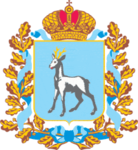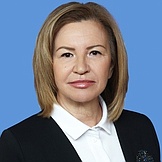Regional flags and emblems


PROFILE
Established 14 May 1928
Capital Samara
The Samara Region is part of the Volga Federal District
Area 53,600 sq km
Population 3 108 900 (2025)
Ethnic groups
(2020 National Census, %)
Russian – 89,61
Tatar – 3,18
Chuvash – 1,56
Other – 5,65
Administrative divisions (2024)
Municipal districts – 27
City districts – 10
Rural towns – 12
Rural districts – 284
Inner — city districts – 9
Geography and climate
The Samara Region is located in southwestern part of the East European Plain on the Volga River.
It borders on the Republic of Tatarstan, and the Orenburg, Saratov and Ulyanovsk regions. It also has a state border with Kazakhstan.
The main river is the Volga River with its tributaries: Samara, Bolshoi Irgiz, Sok, Chapayevka, Bezenchuk, Bolshoi Cheremshan and Syzran. In the region, one can also find the Kuibyshev and Saratov water reservoirs.
The climate is continental and arid. The coldest month is January with an average temperature of −11.2°С, the warmest is July at an average of + 20.2°С.
The region is home to the Sprygin Zhiguli State Nature Reserve, Buzuluksky Bor and Samarskaya Luka National parks.
Government
The legislative branch in the Samara Region is represented by the Samara Regional Duma (Samara Region legislative body), which is a representative unicameral permanent supreme body and the only legislative authority in the Samara Region.
The Samara Regional Duma has 50 deputies elected for five years, with 25 of them running in single-mandate constituencies and the other 25 in the single electoral district in proportion to the number of votes cast for lists of candidates nominated by electoral associations.
The current Samara Regional Duma was elected in September 2021. Its term expires in September 2026.
The executive branch in the Samara Region is represented by the Governor of the Samara Region, the Government of the Samara Region, the ministries of the Samara Region and other executive agencies of the region. The Government of the Samara Region is the supreme executive body in the Samara Region. The First Vice-Governor – Prime Minister of the Samara Region heads the Government and organizes its work and main activities. The First Vice-Governor – Prime Minister of the Samara Region is appointed and dismissed by the Governor of the Samara Region.
The Governor of the Samara Region is the region’s highest-ranking official, who heads the executive branch of the Samara Region. The Governor is elected for five years by Russian citizens who permanently reside in the region. The term of office of the current incumbent expires in September 2029.
Economy and natural resources
Mineral and natural resources in the Samara Region is primarily oil. The region has reserves of hydrocarbon, mineral, construction, mining-engineering and mining-chemical raw materials, and a substantial amount of estimated mineral resources for construction purposes.
The Samara Region is one of Russia’s most economically developed areas. The manufacturing industry accounts for over 40% of the regional GDP. The industrial complex includes mining and processing industries plus the power industry. Development of the region’s economy is based on high-tech industries, such as auto assembly, aviation and space, chemical, and metal industries. Mineral extraction accounts for about 20% of industrial production, with about 99% of that being fuel and energy mineral resources.
The region has developed high-tech automotive, aerospace and petrochemical industries.
The automotive industry, is one of the region’s backbone industries, the main company is the AvtoVAZ.
The region’s aerospace industries develop and manufacture spacecraft, aircraft and rocket engines, component parts for aircraft, and carry out service and repair of aircraft and power systems. The list of these companies includes the Progress Rocket Space Centre, Kuznetsov, Aviacor aviation plant, Aviagregat, Agregat, Gidroavtomatika, and ”Ekran“ Scientific Research Institute.
Petrochemical industries, which include oil production, oil refining and chemical production, account for over one third of the region’s economic potential. The list of major industries includes Samaraneftegaz, Kuibyshev Refinery, Novokuibyshevsk Refinery, Syzran Refinery, Novokuibyshevsk Oils and Additives Plant and KuibyshevAzot.
The region’s agro-industrial complex is a multi-sectoral production and processing system, which accounts for over 4% of the regional GDP.
The region’s crop production includes mostly grains, vegetable oil and fodder crops, potatoes, vegetables, fruit and berries. Livestock farming includes beef and dairy cattle breeding, pig breeding, sheep breeding and poultry farming.
The crop sector has the potential to fully provide the entire region with grains, vegetables, fruit and berries, with a surplus for other parts of the country.
Due to its favourable economic and geographic location, the Samara Region is one of the most important transport hubs in Russia. The region has the largest transport system in the Volga Federal District. This system is the centre for international north-south and west-east transport corridors, which provides the region with transport links of federal and regional significance in every direction.
Culture and tourism
The Samara Region has many long established cultural traditions. It is associated with Sergei Aksakov, Alexander Ostrovsky, Nikolai Garin-Mikhailovsky, Leo Tolstoy, Ilya Repin, Maxim Gorky, Alexei Tolstoy and Eduard Uspensky. During the Great Patriotic War, the Bolshoi Theatre and the Leningrad Drama Theatre were evacuated to Samara (then Kuibyshev). The Kuibyshev Opera and Ballet Theatre was the first theatre to play the Seventh Symphony by Dmitry Shostakovich. Kuibyshev Academic Theatre plays, directed by Pyotr Monastyrsky, were events of great significance in the theatre life of the USSR in its 1960s−1980s.
The Samara Region includes about 1,200 landmarks on the Russian cultural heritage register. The list of historical sites includes three cities: Samara, Syzran and Togliatti.
The Samara Alabin Museum for Historical and Regional Studies, established in 1886, has several branches in the region. The Samara Art Museum is one of the largest in Russia.
The region offers a great number of tours, such as river-cruises on the Volga, and environmental, rural, ethnographic, caving, cycling, horseback-riding and health tours. The Samarskaya Luka National Park offers eco-ethnic tours in the rural area of Shiryayevo and on the banks of Usinsky Bay (Bogatyrskaya Sloboda).
Every year, the Samara Region hosts the All-Russian Grushinsky Festival of bard songs, the World of Bards festival, the largest Russian rock festival called Rock over Volga, the Steppe Races in the Samara Estate of Leo Tolstoy, the Drums of the World and Teatralny Krug festivals, the Anatoliya festival of ethnic and belly dances and the Alla Shelest Classical Ballet Festival.
The region is also known for hosting the Volga Quest international dog sled race, the off-road safari from the village of Shiryayevo to the highest point in the Zhiguli Mountains, rally raid and SUV trial races on Samarskaya Luka, plus the 300 km long Togliatti Bicycle Tour.
The Samara Region has several dozen health resorts and prevention centers offering treatment for various illnesses. The list of resorts includes the Volga Cliff Resort on the shore of the Zhigulyovskoye Sea, and the Sergievsky Mineral Waters, Samarsky and Chkalova resorts.


